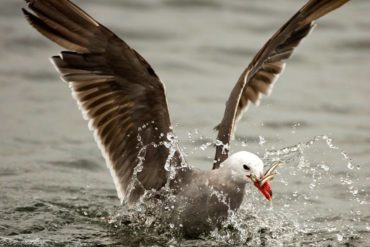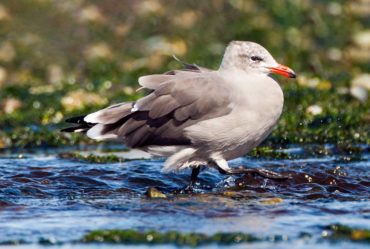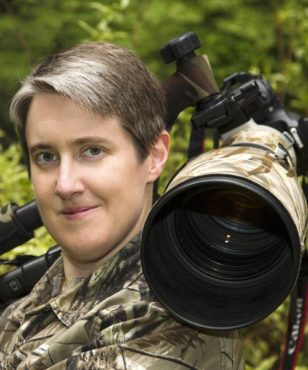
(This photo by Janine Schutt is featured on Kitsap Audubon Society’s “Important Bird Area” interpretive sign at Point No Point County Park.)
A little-known fact, outside the world of birding, is that there is no such bird as a “seagull.” Rather, the term “seagull” is an informal name given to any member of the Laridae (Greek for “ravenous seabird”) family.
Gulls, as they are correctly called, are most closely related to terns. They hold little interest to nonbirders, who generally classify them all as “seagulls,” often with contempt.
Omnivorous in nature, gulls eat anything people may consider disgusting, be it alive or dead. That being said, gulls are often passed off as unimportant and uninteresting.
But nothing could be further from the truth. If there were no gulls, our shores would be covered in rotting sea life. Gulls are scavengers, which allows them to play an important role in the ecosystem as a feathered cleanup brigade of the beach. Thus, if there were no gulls, there would be few, if any, pristine beaches to enjoy.
There are over 50 species of gulls in the world. Most of them make their home around salt water, although some live inland and never go near the sea.
Even for experienced birders, identification of gulls can be challenging. Nearly all of Washington’s gulls have gray-and-white bodies and yellow bills. There are hybrids that cause mass confusion.
Most gulls don’t reach maturity until their fourth year. Multiple species of immature gulls look similar, with plumage that changes annually.
It’s easy to see why beginning birders don’t usually bother with “seagulls.” An inexperienced bird watcher may quickly dismiss a “squabble” of gulls as all one kind. On the other hand, a highly skilled birder may look more closely and identify five different species within the flock.
But there is one gull that really stands out. It is the only gull in Washington with sooty-gray feathers and a black-tipped, bright orange-red bill. The collection of singular features makes its identification unmistakable. This unique gull is the Heermann’s gull, named for Dr. Adolphus Heermann, a collector of avian specimens in mid-19th century California.

Even with its distinctive appearance, perhaps the most interesting trait of the Heermann’s gull is its reverse migration pattern. While most avian migrants head north to breed and south for the winter, Heermann’s gulls fly south to breed and north for the nonbreeding season.
The gregarious Heermann’s gull breeds in large colonies on remote islands west of Mexico in the Gulf of California. By late May, most are finished breeding and begin to travel north, usually in small groups.
There is a strategy to the Heermann’s gull’s reverse migration. This aggressive, crow-sized gull sees an opportunity to tag along with northward migrants. Their migration is precisely timed with that of the brown pelican. Why go fishing when someone else can do the work for you? When a pelican surfaces with a fish in its pouch, a Heermann’s gull is often there to steal its meal.
When pelicans aren’t around, the resourceful Heermann’s gull harasses other marine birds, making them ditch their catch. It then grabs the easy snack.
When it has to provide its own meal, the Heermann’s gull flies low over the water, where it drops down or dives to catch small fish, commonly known as forage fish. It also feeds on crustaceans and mollusks and contributes to beach cleanup efforts by eating dead sealife that has washed ashore.
During breeding season, the Heermann’s gull dons a white head, which darkens to a speckled gray in the nonbreeding months. Its body is sooty-gray year-round.
The Heermann’s gull can be found along Washington’s outer and inner coastlines from June to October, along with a few stragglers in November.
In Kitsap County, Heermann’s gulls are most often seen in late summer and early fall, particularly around Puget Sound. The shorelines around Hansville, at the north end of the peninsula, afford the best opportunities for observing them.
Point No Point County Park, one of the best birding sites in the state and a designated Important Bird Area by the National Audubon Society, is the best place to look. Ferry terminals and crossings also provide good opportunities for spotting a Heermann’s gull. Other reliable locations include Eglon Boat Launch and Fay Bainbridge Park.
Heermann’s gulls are subject to nest disturbance by those who trek onto their breeding islands near Mexico. This may contribute to their “early warning” listing on the Audubon Washington Vulnerable Birds List. Kitsap residents can assist Heermann’s gulls and other seabirds by conserving forage fish and keeping beaches and waterways free of debris and pollution.
Start watching gulls and you will see that they are not all the same. The Heermann’s gull is a striking bird that stands out among the rest. Along with other gulls, it plays a vital role in the ecosystem. We owe it our gratitude and protection.



























Comments